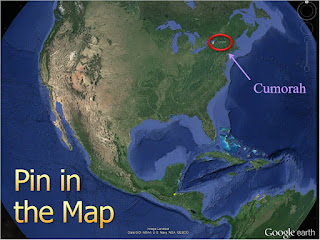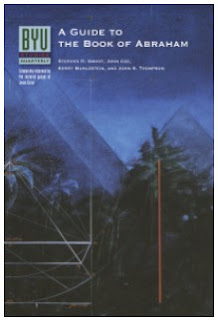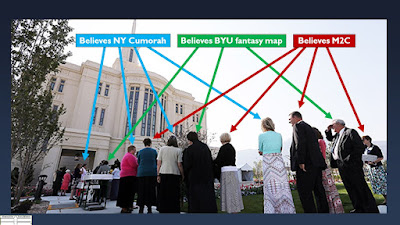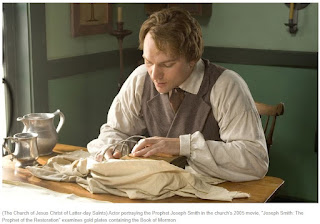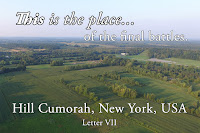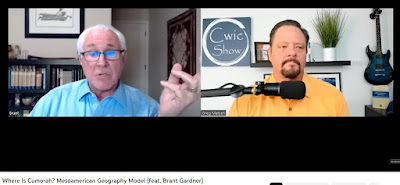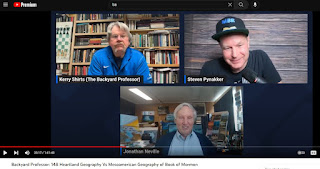Mike Parker clarifies, part I
A couple of weeks ago on my Interpreter blog, I posted a table that summarized the differences between my approach to Church history and the approach taken by prominent LDS scholars, including Dan Peterson, Mike Parker, Stephen Smoot, Jack Welch, Brant Gardner, Royal Skousen, and their followers and donors. My table was based on the published work of these scholars.
In response, Mike Parker wrote me an email to correct my table, at least with respect to his own views. [For those who don’t know Mike Parker, see below*]
I appreciate the feedback so we’ll discuss it in 5 parts. This post is for Part I.
Mike’s response is a good summary of the arguments in favor of M2C (the Mesoamerican/two-Cumorahs theory) that have been made for over 100 years. I don’t say these M2C arguments are unreasonable or irrational. They are among the multiple working hypotheses that I always acknowledge and cite.
I encourage everyone to know what the M2C advocates teach. Everyone is entitled to their own beliefs, and we should all seek to understand their explanations.
As a former M2C advocate, I think I understand their explanations, and I’m always eager for better information and correction, as I’m showing in this post. However, in my opinion, the M2C explanations are not the best explanations for the evidence, and all interested parties deserve to know why.
More importantly, everyone realizes that any legitimate LDS scholars would freely acknowledge not only the M2C interpretations of the text, the historical record, and extrinsic evidence, but also the explanations that do not support M2C; i.e., the interpretations that support the New York Cumorah. Those who insist on acceptance of their own beliefs, without offering fair and open consideration of alternative interpretations, are not scholars but mere advocates, like corporate marketing executives.
Latter-day Saints and everyone else interested in the Restoration deserve a legitimate comparison of different interpretations–multiple working hypotheses–of the text, the history, and the evidence. As of today, with the exception of Mike Parker, the LDS scholars mentioned in this post have refused to provide, or even to participate in developing, such a comparison.
Thus, kudos to Mike.
I’m happy to use his input to compare the alternatives to help people make informed decisions. I hope this is a step towards a more comprehensive comparison. If all LDS scholars who speak or publish on this topic participated, Latter-day Saints and others would have a reliable basis for making informed decisions.
This table shows my comments along with Mike’s. I numbered his paragraphs for ease of reference. To be sure, Mike’s comments are brief, but they incorporate considerable material. Hence, my detailed discussion.
If I have in any way misunderstood Mike’s points, I hope he will clarify further.
|
Jonathan Neville |
Jonathan Neville’s synopsis of |
Mike Parker |
|
Joseph |
Joseph |
1. There 2. Early 3. Extrinsic evidence does not confirm that the |
Discussion.
Mike: 1. There has been no divine revelation that identifies the hill near Joseph Smith’s home as the hill Cumorah of the Book of Mormon. Claims that Moroni called the New York hill Cumorah are late and secondhand.
My response: Mike starts by avoiding the main point; i.e., that, according to Mike, Oliver did not tell the truth about Cumorah. While it’s easy to understand why Mike (and other M2C advocates) avoid this point, that’s no excuse for not owning their own position. Their discomfort does not excuse their obfuscation.
Mike’s second sentence contradicts his first; i.e., he acknowledges there is historical evidence that Moroni called the New York hill “Cumorah,” which would constitute “divine revelation” by any standard. By not specifying which “claims” he rejects, we must infer he rejects all of the historical evidence supporting the New York Cumorah. At the same time, he fails to support his first sentence with any evidence at all, beyond his mere assertion.
Fundamentally, Mike tries to persuade readers to think past the sale; i.e., he expects readers to assume that the only way Oliver could state it was a fact that Cumorah is in New York is if (i) Oliver (or Joseph) had received divine revelation on that point, (ii) they recorded that revelation as such, and (iii) such a record is extant today. But that’s a phony requirement for 3 reasons:
1. Oliver’s statement of fact is supported by the personal experience he related about when he and Joseph entered the repository of Nephite records in Cumorah multiple times; i.e., no “divine revelation” required.
2. Mike’s declaration that “there has been no divine revelation” is not supported by any evidence, nor could it be, because of the inherent impossibility of proving a negative [i.e., absence of an extant record of such a revelation is not evidence that no such revelation occurred].
3. In any case, as Mike admits in his second sentence, the historical record includes specific evidence of divine revelation about the New York Cumorah. Mike rejects the record as not credible, a conclusion reasonable people can disagree about, but that does not support his claim that no such revelation occurred.
Detailed response:
At the outset, Mike forgot to acknowledge that in Letter VII, Oliver declared it was a fact that the Hill Cumorah/Ramah was the same hill in New York from where Joseph obtained the plates. This is why I framed the issue as a binary; i.e., Oliver either told the truth or he lied. He left no room for an inference that he was speculating. Mike, like other M2C advocates, evades this point with a series of logical fallacies.
Mike’s claim that there is “no divine revelation” is the same premise used by RLDS scholars Stebbins and Hills 100 years ago, as I discussed here: https://www.lettervii.com/p/origin-and-rationale-of-m2c.html. Stebbins and Hills were the first to come up with the Mesoamerican/two-Cumorahs theory (M2C). Over the objections of Joseph Fielding Smith and others, LDS scholars adopted M2C and promoted it as their own.
The “no revelation” argument is a sleight-of-hand rhetorical tactic.
First, the argument glides over the distinction between “revelation” and “experience.” Most people consider a truth claim based on physical, tangible experience to be more credible than a spiritual (or psychological) revelation, which in turn is more credible than intellectual speculation. Thus, Joseph Smith described the First Vision as a physical experience (“I saw a pillar of light… I saw two personages”) instead of merely relating a spiritual impression, revelation or dream. We think of the restoration of the Priesthood by John the Baptist as an experience, not merely a “revelation.” Thus, we can say there was “no divine revelation” about the restoration of the Priesthood; instead, it was a physical experience. [If Mike is arguing these events were revelations and not experiences, then we have a more fundamental problem with all of the truth claims by Joseph and Oliver.]
The distinction is crucial because Oliver claimed he and Joseph had an actual experience when they entered the repository of Nephite records in the New York hill, as reported by Brigham Young and others. Thus, Oliver’s declaration that it was a fact that Cumorah is in New York was based at least in part on his personal experience, which supersedes revelation in terms of credibility.
[Although Mike didn’t mention it, M2C advocates typically dismiss Oliver’s accounts of the visit to the repository as a spiritual experience because Heber C. Kimball referred to a “vision.” However, in context, Heber undoubtedly meant a “view” of reality in the same sense as Joseph’s First “Vision” account.]
Second, while it’s true that we have no extant first-hand record that Oliver and Joseph claimed a specific revelation about Cumorah, that obviously does not mean neither of them ever received such a revelation.
Third, we actually do have a second-hand record that Joseph learned about Cumorah through a revelation because, according to Lucy Mack Smith, Moroni revealed the name of the hill to Joseph the first time they met, as anyone can see in the Joseph Smith Papers here.
https://www.josephsmithpapers.org/paper-summary/lucy-mack-smith-history-1844-1845/41
She also recorded that Joseph referred to the hill as Cumorah in early 1827 before he even got the plates.
These may be two of the unidentified accounts to which Mike refers when he writes “Claims that Moroni called the New York hill Cumorah are late and secondhand.” Lucy’s account was recorded after Joseph’s death in 1844, which some historians consider “late.” However, Lucy had been relating Joseph’s history before she finally had it recorded.
In fact, Lucy’s claim of a revelation from Moroni was corroborated by Parley P. Pratt as early as 1830 when, during their mission to the Lamanites, he recorded what Oliver was teaching the Indians; i.e., that “This Book, which contained these things, was hid in the earth by Moroni, in a hill called by him, Cumorah, which hill is now in the State of New York, near the village of Palmyra, in Ontario County.”
If Mike refers to Oliver’s Letter VII, published in 1835, as “late,” it still is earlier than Joseph’s own testimony in 1838, which has been canonized as Joseph Smith-History.
If Mike refers to D&C 128:20, first published in 1842 as a letter from Joseph to the Saints,
Mike: 2. Early Latter-day Saints believed that the two hills were the same. That belief was based on assumption, and we cannot and should not fault them for coming to that conclusion. They, of course, did not realize their own assumptions, which is an extremely common human tendency.
My Response: Mike offers zero evidence to support his claim that “that belief was based on assumption.” By any reasonable standard, given what Lucy Mack Smith and Parley P. Pratt tell us, the historical record indicates “that belief” in the New York Cumorah was based on what Moroni told Joseph Smith the first night they met. Other historical evidence corroborates this basis for what early Latter-day Saints believed, such as David Whitmer remembering that the first time he heard the word “Cumorah” was when he met the divine messenger who was taking the abridged plates from Harmony to Cumorah.
The irony of Mike’s position is that he seems oblivious to the reality that his rejection of the historical record is based on his own assumption that Cumorah cannot be in New York. Although he observes that making assumptions is an extremely common human tendency, he then fails to recognize that his entire argument is based on a mere assumption of his own.
Mike: 3. Extrinsic evidence does not confirm that the New York hill was the hill Cumorah of the Book of Mormon, and internal evidence from the text also strongly suggests that it was not.
My Response. The argument about extrinsic evidence in turn relies on a series of assumptions about the text actually says, and then using those assumptions to generate criteria for extrinsic evidence. IOW, it’s all circular reasoning. Someone who assumes Cumorah is in Mesoamerica can interpret the text accordingly and then find extrinsic evidence to support that interpretation. A shorthand example is the requirement for volcanoes, which the text never mentions or describes, yet which the M2C proponents insist is implied by the text.
Similar circular reasoning supports the New York Cumorah. Someone who assumes Cumorah is in New York can interpret the text accordingly and then find abundant extrinsic evidence to support that interpretation.
Thus, the “extrinsic evidence” argument is not a legitimate basis for rejecting what Oliver and others taught about the New York Cumorah.
The internal evidence argument is also circular reasoning. While M2C proponents can find a way to interpret the text to imply two separate hills (repository vs. stone box), nothing in the text states or implies that Moroni did not deposit the abridged plates in the same hill Cumorah where the repository of records was located; i.e., in New York. Orson Pratt explicitly explained that there were “two departments” in the hill Cumorah in New York, and nothing in the text contradicts that explanation.
Furthermore, as described in Letter IV, Moroni told Joseph that the record was “written and deposited not far from” Joseph’s home near Palmyra, New York. If the record was written in the vicinity of where it was deposited, then it was written in New York.
People can reject this historical evidence as well, but the historical record supports and corroborates the New York Cumorah.
It should go without saying that the New York Cumorah makes a lot more common sense than the idea that Moroni hauled heavy gold plates, along with other Nephite relics, thousands of miles from “another Cumorah” in Mesoamerica to western New York.
_____
Part II next.
_____
*Mike Parker is a contributor to the Interpreter. I don’t know much about him. Recently he claimed he was the infamous “Peter Pan” who writes an ad hominem blog that Dan Peterson has been promoting for years, but that doesn’t make sense because articles in the Interpreter list Mike Parker and Peter Pan as separate contributors. In the last two weeks, I offered to meet Mike for lunch when I was in southern Utah, but he refused. Because I have never met him personally (that I recall, anyway), he is merely a name on an email, which means he could be no more real than the Peter Pan pseudonym, but I’ll proceed on the assumption Mike Parker is a real person.
Source: About Central America
